Waves and Moons
Siri Aurdal and Synnøve Anker Aurdal
This summer we are happy to open an exhibition with the two remarkable artists Siri Aurdal and Synnøve Anker Aurdal.
With their tapestries and sculptures, Siri Aurdal (b. 1937) and Synnøve Anker Aurdal (1908–2000) have added something new and radical to Norwegian art. Synnøve Anker Aurdal brought woven art into a new era by including elements of abstraction and experimentation. Siri Aurdal uses materials from building projects and industrial production in larger sculptural works.
The exhibition title ‘Waves and Moons’ points to central motifs in the two artists’ works. Synnøve Anker Aurdal drew inspiration from nature throughout her long career, often allowing impressions from nature to interact with philosophical and political expressions. She was especially influenced by Eastern philosophy, and the moon as a motif rich with Buddhist symbolism recurs in several of her most significant tapestries. We find the wave motif in Siri Aurdal’s Plexiglas sculptures from the 1960s and the 2010s. The striking pipe sculptures from the late 1960s are shaped into monumental curving forms. As a signature element in her art, the wave form symbolises a connection between maths and nature, rationality and art. The title ‘Waves and Moons’ can also relate to forces in nature and can thus be read as picturing the great significance which Synnøve Anker Aurdal and Siri Aurdal have had and continue to have in Norwegian art.
The two artists are mother and daughter and at the same time prominent exponents for modern Norwegian art. Synnøve Anker Aurdal’s artistic practice began to be particularly influential in the late 1950s, and Siri Aurdal distinguished herself with important exhibitions throughout the 1960s. Even so, their inspiration and interests encompass a much longer time span in Norwegian history. Synnøve Anker Aurdal looked back to the oldest extant Norwegian weavings. Like Frida Hansen and Hannah Ryggen before her, she drank from the well of tradition in order to create her own version of what tapestries can express for us today. Siri Aurdal, meanwhile, has selected her materials from amongst the products of Norway’s early oil industry and turned them into sculptural installations. In the mid-1900s she in many ways broke with expectations for what a female artist should work with. As their works show, the two artists are anchored in Norwegian culture and history at the same time as they have come up with new and radical forms of expression.
Despite the generational difference, both artists were active in the 1960s. Several works in the exhibition are from this decade. Synnøve Anker Aurdal allowed herself to be inspired by abstract painting and innovative international textile art. She built a bridge between the traditional field of textiles and pictorial art. Over time her works also became increasingly three-dimensional; they can trigger thoughts of reliefs or textile sculptures. This way of working has interesting connections to concurrent tendencies in Polish fibre art, not least as seen in works by Magdalena Abakanowicz. Siri Aurdal immersed herself in the Postwar period’s international avantgarde currents, combining an interest in geometry with a desire to create socially engaging art, such as we can see in works by the Brazilian artists Hélio Oiticica and Lygia Clark around the same time. Like her colleagues, she was strongly influenced by political events. Her radical exhibition ‘Omgivelser’ (‘Surroundings’) at the gallery Kunstnernes Hus in Oslo in 1969 can be seen as a reaction to the civil unrest in Paris the preceding year. She invited other artists to express themselves by writing directly on her large wave-like sculptures that were made with industrial pipe elements. The exhibition proved to be an important event at the time, although Norwegian art history has only later managed to acknowledge it fully. Both Synnøve Anker Aurdal and Siri Aurdal have related actively to key international currents and brought new impulses to the Norwegian artworld.
Siri Aurdal
Interview, 1968/2013
Transparent tinted acrylic glass
Stavanger Art Museum, MUST

Siri Aurdal presented sculptures made of acrylic glass for the first time at an exhibition in Galleri Kringla in Oslo in 1968. She was then a member of the politically-oriented artist group GRAS and was very interested in art’s political, collective and social rolls. The transparent material made viewers aware of each other, facilitated their interaction and enabled an active dialogue between the individual viewers and the art work. Interview was produced anew for the exhibition Hold stenhård fast på greia di: Norsk kunst og kvinnekamp 1968 – 1989 (Hold Firmly onto Your Things: Norwegian Art and Women’s Activism 1968–1989), curated by Eline Mugaas and Elise Storsveen, in connection with the centenary of women’s suffrage in Norway in 2013. It was from this exhibition, which was also held at Kunsthall Stavanger in 2014, that the work was purchased for Stavanger Art Museum’s collection.
Siri Aurdal
Conversations, 2018
Transparent tinted acrylic glass
Kode, Bergen
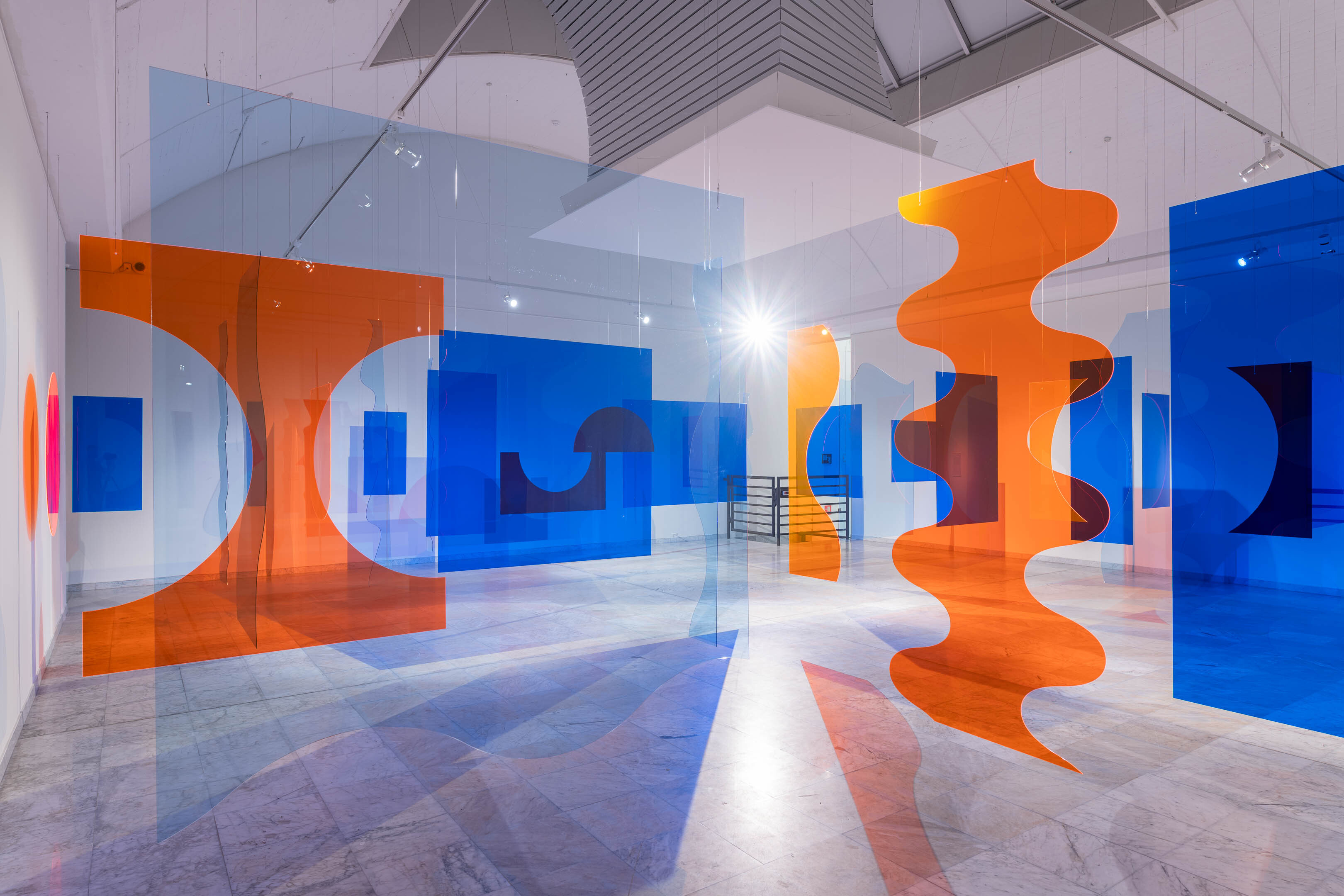
This work is such that you walk between its various parts and observe how it changes in relation to your movements. The artist’s choice of acrylic glass as a material relates to her interest in Op Art and Kinetic Art, two currents that were prominent in the 1960s. Aurdal had seen works by, among others, the Argentinian artist Julio Le Parc (b. 1928) in Paris in 1962, and he had also participated in the group show Op-Art at the gallery Kunstnernes Hus in Oslo in 1968. Le Parc was a member of the artist group GRAV (Group de Recherche d’Art Visuel), which sought to acknowledge the viewer’s creative role when encountering works of art. The group’s starting principles were to stimulate the creative force in individual viewers and to have art to play a more active role in society. Ideas such as these were very significant for Aurdal and her Norwegian colleagues, who were early to explore the sociopolitical potential of their works.
Siri Aurdal
Wavelengths (Stavanger), 2024
Fibreglass-reinforced polyester tubes and metal fittings
Courtesy of the Artist and Galleri Riis, Oslo

In 2016 Aurdal exhibited a new version of the work at Kunstnernes Hus, this time through collaboration with the artist Eline Mugaas. That same year in the autumn, a version of the work was shown outdoors in Frogner Park in Oslo. The exhibition generated renewed interest in Aurdal’s art, and in 2017, with the pipe sculpture Onda Volante (Flying Wave), she represented Norway in the Nordic Pavilion at the Venice Biennale. It is now also possible to see the sculpture Bølgelengder rekomponert (Wavelengths Recomposed) at the National Museum in Oslo.
Synnøve Anker Aurdal
Red Moon, 1968
Tapestry in wool, linen and red fire-lacquered copper wire from the Norwegian Electric Cabel Factory
The City of Oslo Art Collection
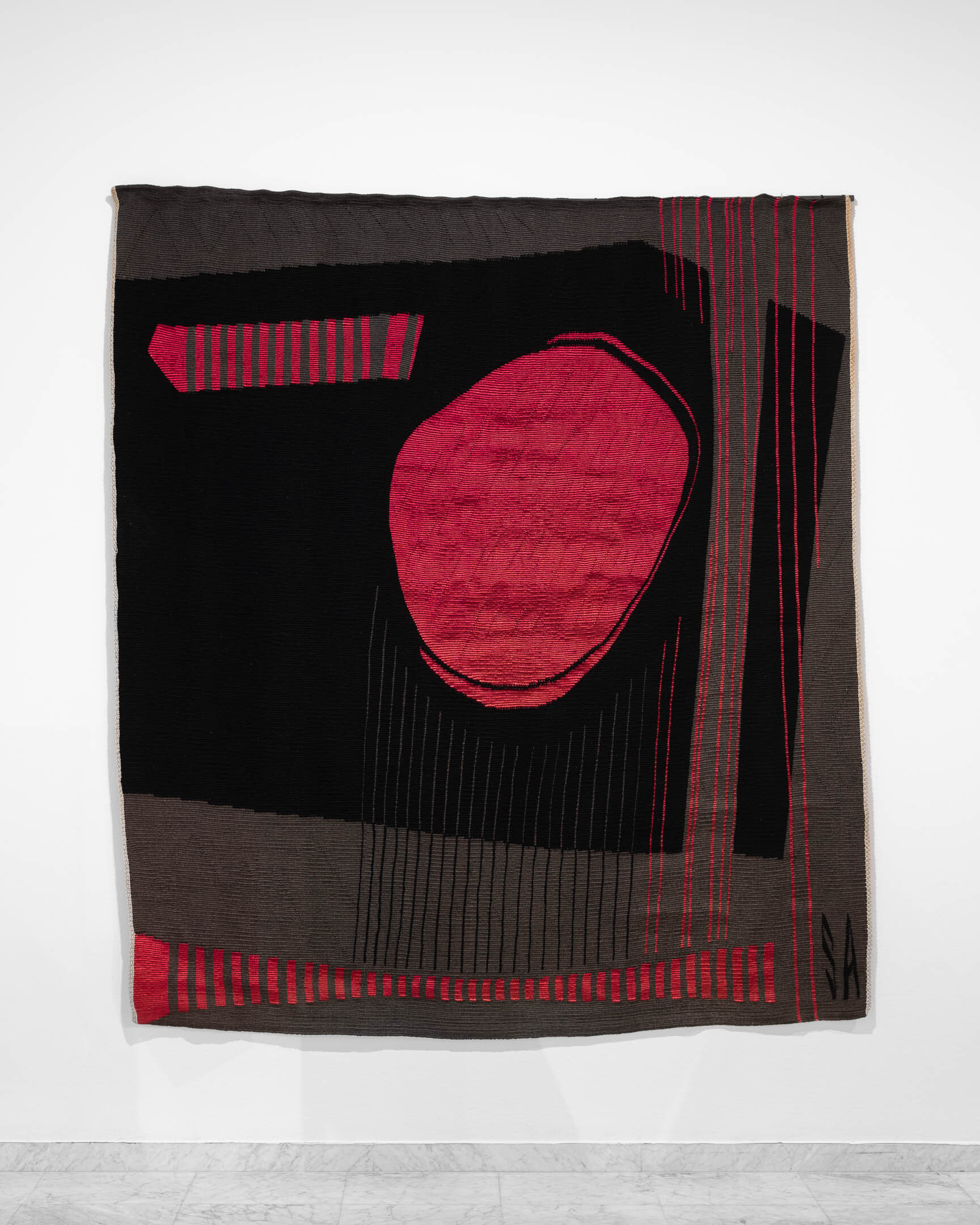
Throughout the 1960s Synnøve Anker Aurdal developed an increasingly abstract visual language emphasising simple shapes. The moon is a recurring motif in tapestries from this period, one example being Magisk måne (Magic Moon), which hangs in the National Museum in Oslo. Rød måne (Red Moon) was selected for an exhibition in the Nordic Pavilion at the Venice Biennale in 1982. In fact, Synnøve Anker Aurdal was the first female artist to represent Norway with a solo exhibition in the Nordic Pavilion. The exhibition featured 12 tapestries, three of which can be seen in this exhibition: Red Moon, Kinesisk visdom (Chinese Wisdom) and Sølvklode (Silver Planet).
Synnøve Anker Aurdal
M’illumino d’immenso, 1998
Tapestry in wool
Courtesy of the Artist's Estate and Galleri Riis, Oslo

Throughout her entire career, Synnøve Anker Aurdal turned to poetry to find motifs and themes for her tapestries. This tapestry is inspired by the poem Mattina (Morning) by the Italian Giuseppe Ungaretti (1888–1970). Ungaretti wrote poems that express meaning in very few words. Mattina consists only of the words M’illumino d’immenso, which can be translated as ‘I illuminate (myself) with immensity’.
Synnøve Anker Aurdal
Iceland Clock 1976
Copper, rope, wool, iron nails
Courtesy of the Artist's Estate and Galleri Riis, Oslo
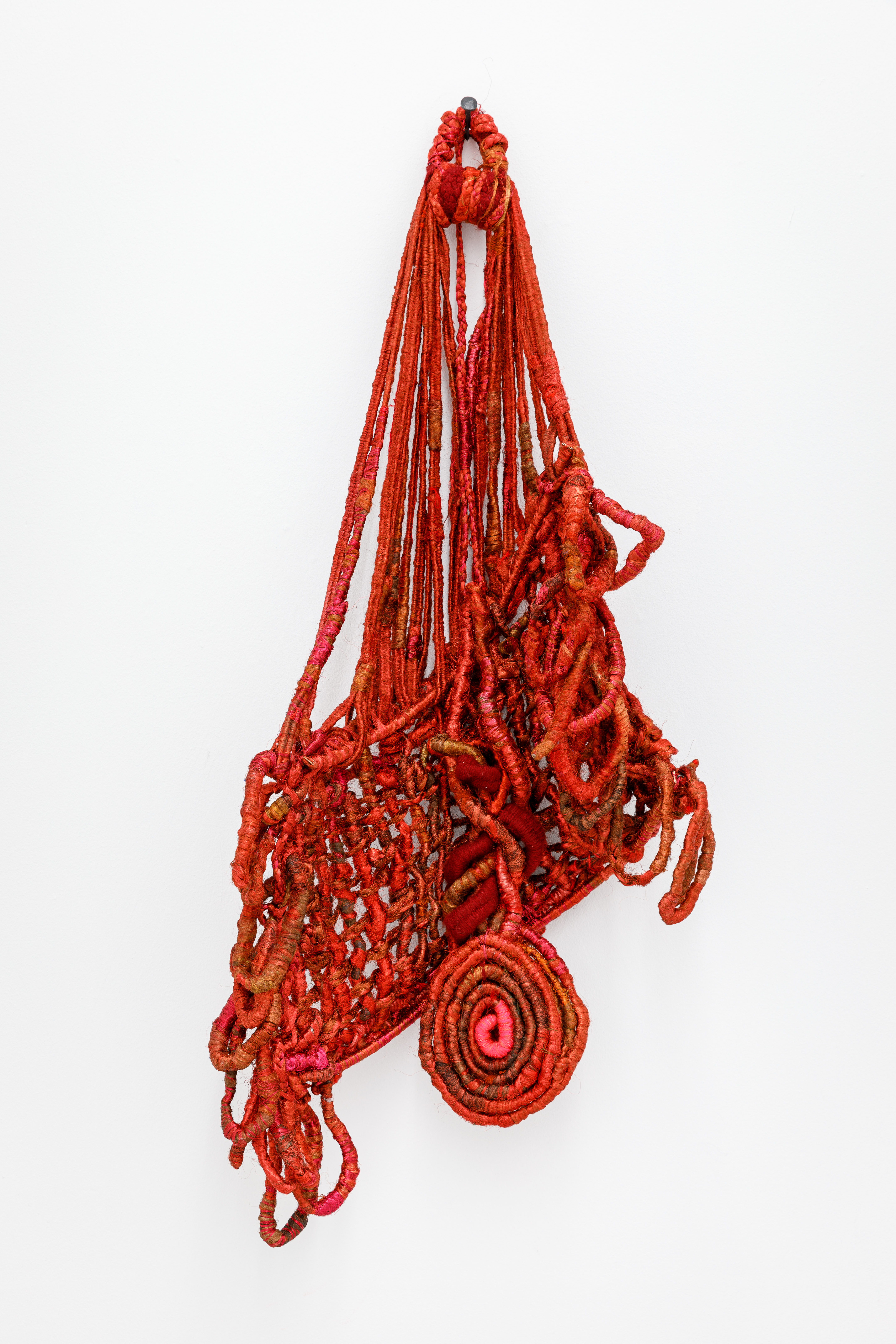
In the 1970s Synnøve Anker Aurdal’s tapestries became increasingly three-dimensional and appeared more as reliefs or textile sculptures. This way of working parallels the practices of some of her contemporaries, for instance Magdalena Abakanowicz (1930–2017) and Brit Fuglevaag (b. 1939).
Synnøve Anker Aurdal
Chinese Wisdom, 1967
National Museum of Decorative Arts, Trondheim

As the title implies, Anker Aurdal was inspired by a Chinese poem while weaving this tapestry. The letters and words in different sizes are spread across the surface. Their placement may trigger thoughts of vertical writing, as in Chinese. If you first read the text at the bottom, then the large skinny letters in the middle, and then the letters at the top, it says (in Norwegian) ‘To get up in the morning and paint letters…a metre tall…is this not happiness’.
Synnøve Anker Aurdal
Even More Bureaucrats, 1993
Tapestry in wool and silk
National Museum of Decorative Arts, Trondheim
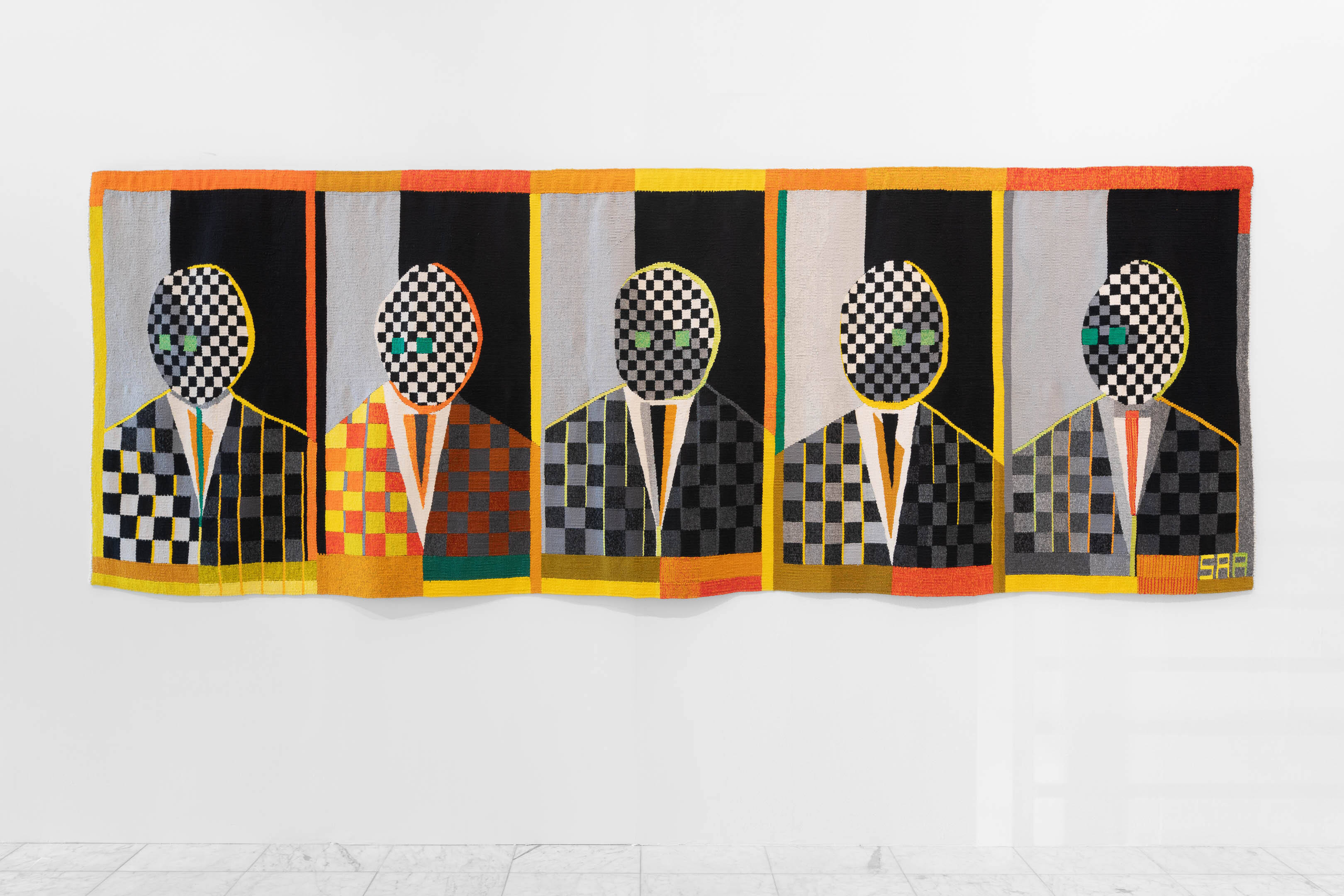
There’s a humorous relationship between the title and motif of Synnøve Anker Aurdal’s ‘bureaucrat tapestries’ that makes their message obvious. She wove several works with this motif, and it may have been inspired by her colleague Morten Krohg, who in 1979 painted a pictorial series called Byråkrater (Bureaucrats). With the bureaucrat tapestries, Anker Aurdal perfected a visual language of simple geometrical shapes in combination with a well-developed taste for political satire.
Synnøve Anker Aurdal
Red in the Red, 1997
Tapestry in wool
National Museum of Decorative Arts, Trondheim

During the 1980s Synnøve Anker Aurdal’s tapestries regained a tighter expression, one which she largely continued to work with for the rest of her life. No longer experimenting so much with new materials and three-dimensional surfaces, she chose instead to weave flat and even surfaces. The figuration was clearer, and we can recognise themes from tapestries she made in the 1950s. In this tapestry we see, for example, rows of stylised human figures and masks. The works from this period also show that after many years of artistic practice, she mastered the monumental format.
Synnøve Anker Aurdal
Portrait Blue, 1986
Tapestry in wool and artificial silk
National Museum of Decorative Arts, Trondheim
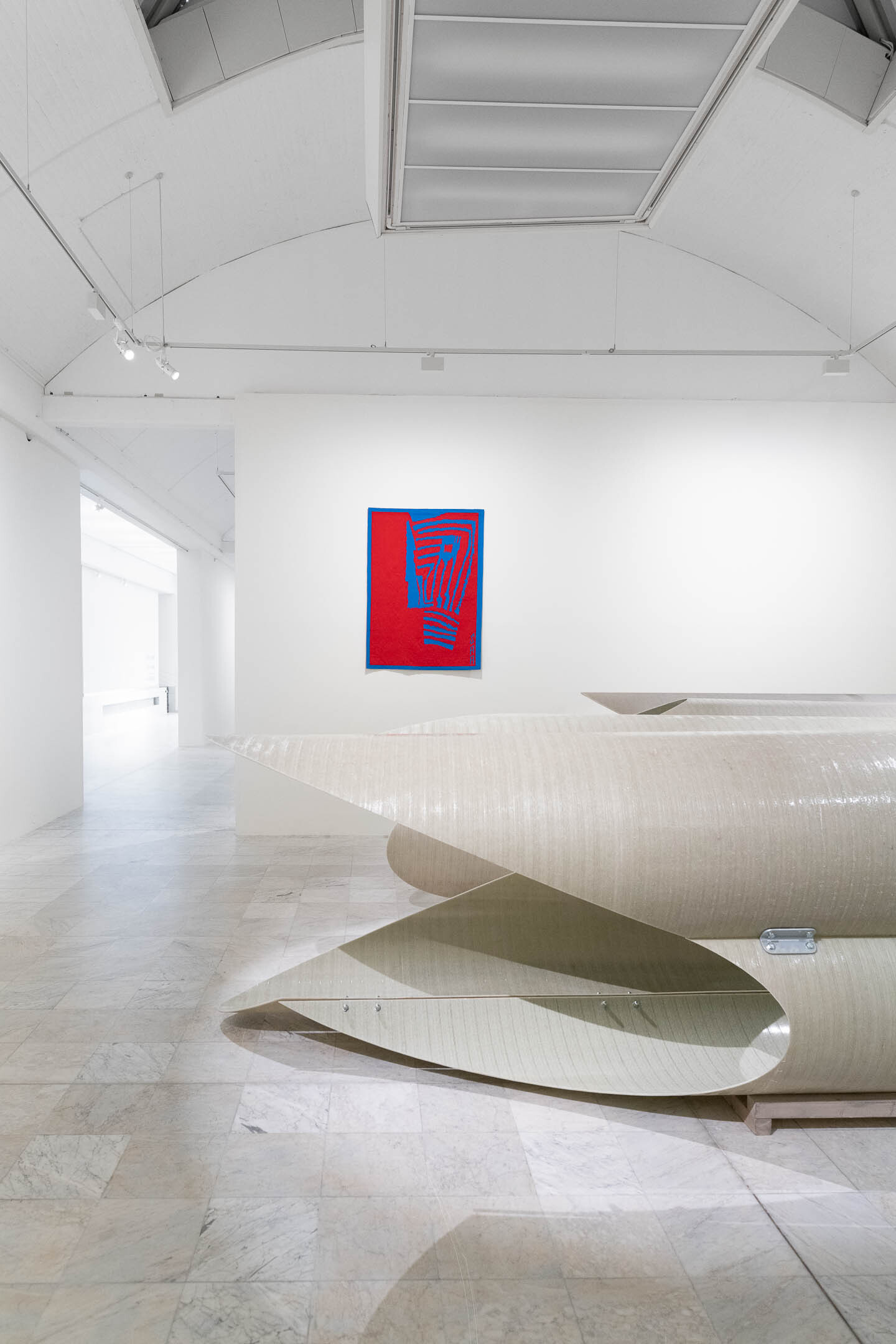
Synnøve Anker Aurdal was very interested in the mask motif and returned to it time and time again. The motif is well-suited to testing out colours and contrasts, such as we see in this tapestry. The blue artificial silk stands in contrast to the bright red background and creates an optically vibrating effect that alludes to Op Art. This is the first of three tapestries woven at a tapestry studio in Aubusson, France.
Synnøve Anker Aurdal
Seven Samurai, 1973
Wool and silk cords
National Museum of Decorative Arts, Trondheim

This tapestry is inspired by a Japanese film with the same title. In the film, seven Japanese samurai try to protect their village from a gang of bandits. It is easy to imagine that this figure has enough power to scare off even the most menacing intruders. As fibre art, the tapestry is exceptionally interesting. It is as if the form’s negative space is as important as the positive space comprised of woven elements.
Synnøve Anker Aurdal
The Waterfall, 1984–89
20 wide and 17 narrow braided vinyl ropes wrapped in metal thread, acrylic glass plate and mirror
Astrup Fearnley Collection
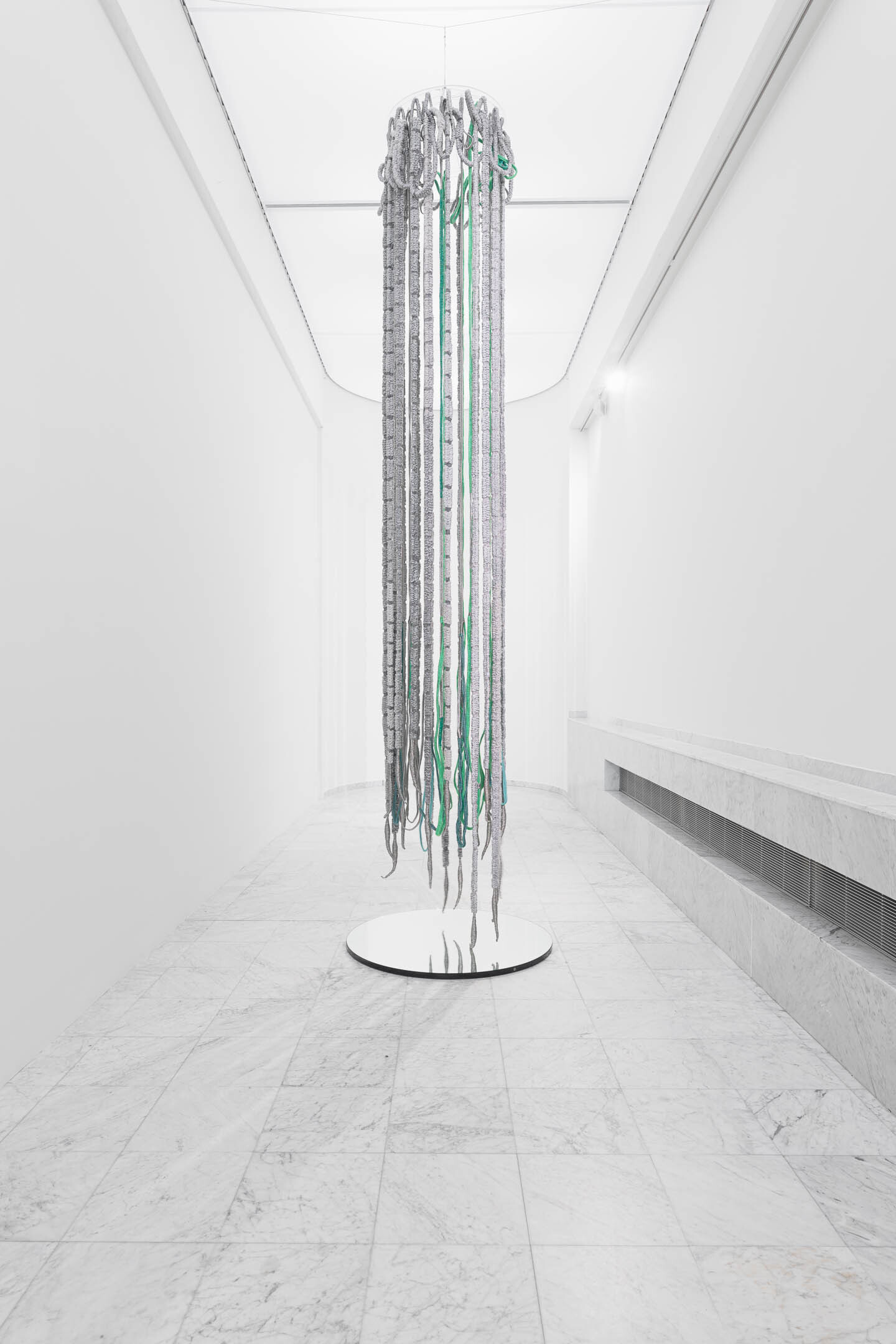
Over time Synnøve Anker Aurdal experimented more and more with materials to find out how she could create the effects she wanted. This fully three-dimensional work hangs from a single point in the ceiling and is closer to being a sculpture than a traditional weaving. The mirror on the floor is an important part of the work. It contributes to a feeling of infinity, which we can also experience when encountering waterfalls in nature.
Synnøve Anker Aurdal
Telegram, 1968
Tapestry
Astrup Fearnley Collection
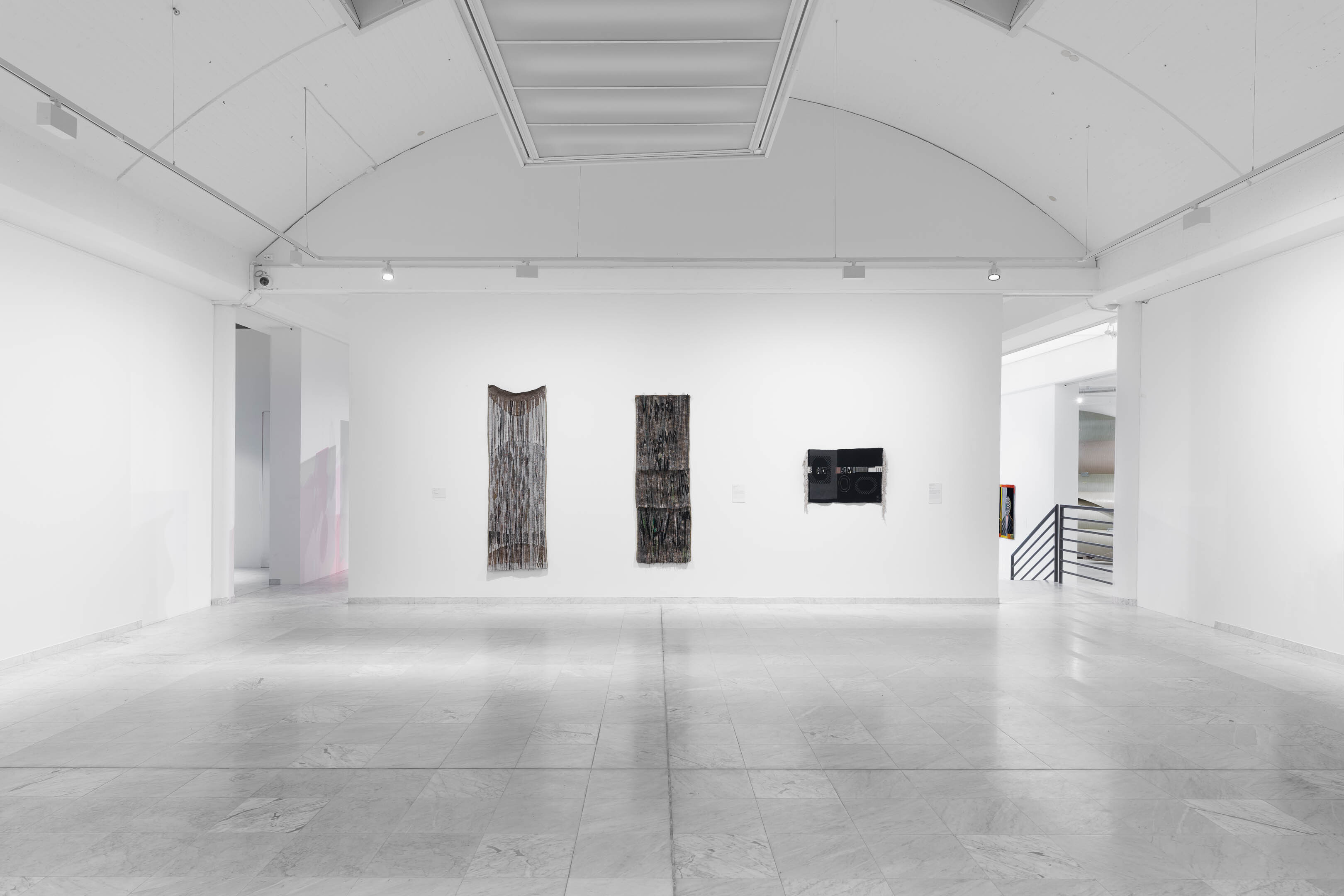
Nature has meant a great deal to Synnøve Anker Aurdal and Siri Aurdal. The text woven into this tapestry was written by Siri Aurdal when she was 10 years old. She was practicing writing telegrams and composed a sentence meaning ‘From where I now stand I see the ocean’. This poetic statement inspired her mother to weave this tapestry.
Synnøve Anker Aurdal
Be Your Own Poet 2, 1973
Tapestry
The Tangen Collection
‘“Viewers need to use their imagination and put something of themselves into an artwork; this is the only way to have a rich experience”, says Synnøve Anker Aurdal.’ This was written by the art historian Hjørdis Danbolt in her eulogy for Synnøve Anker Aurdal, published in the newspaper Bergens Tidende, 5 April 2000. In several of Anker Aurdal’s tapestries we recognise the direct and clear exhortation: Be Your Own Poet!
Synnøve Anker Aurdal
Silver Planet, 1970
Tapestry with linen warp and weft of wool yarn, nylon and metal thread, and metal chains of nickel and copper
The National Museum
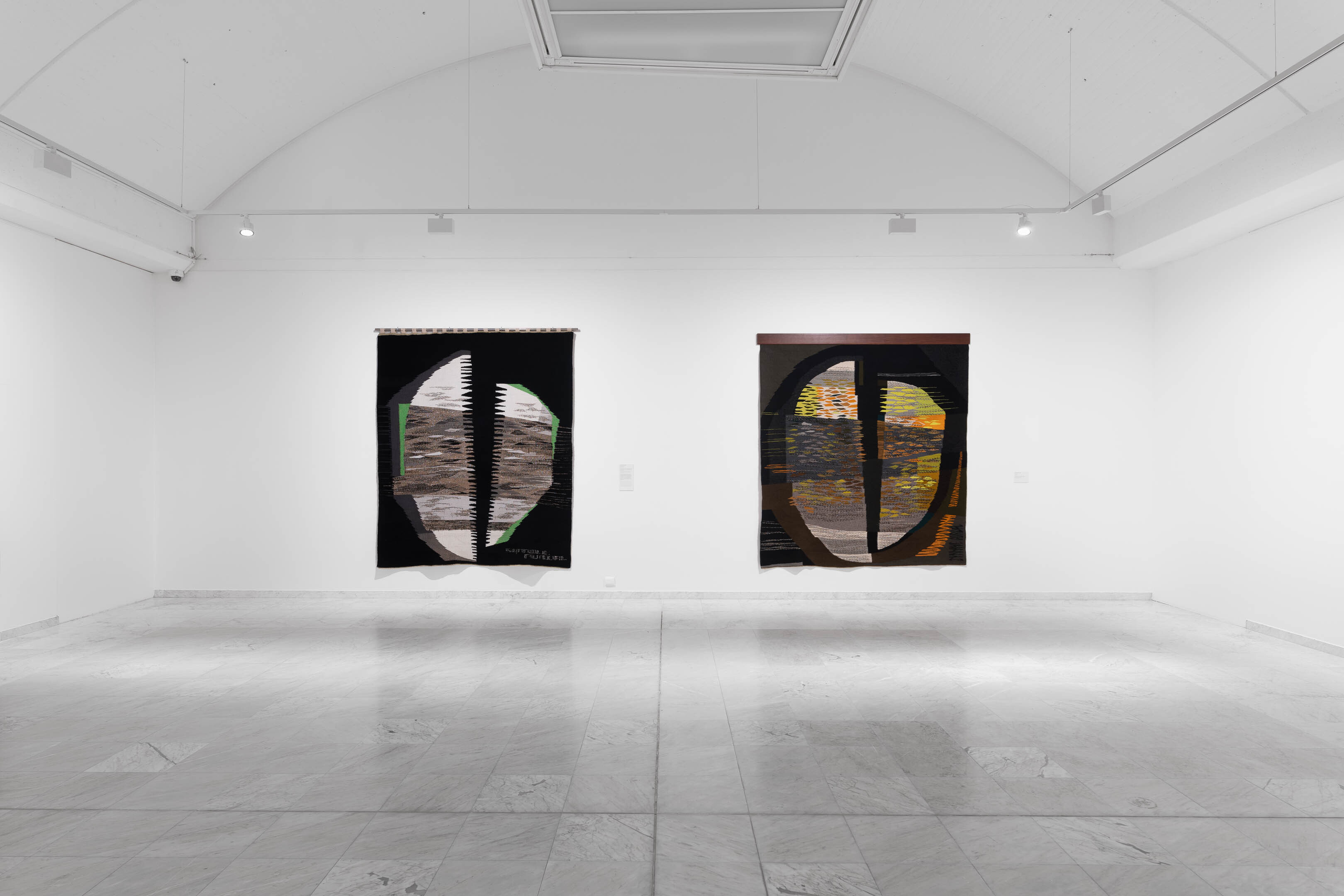
Synnøve Anker Aurdal played an important role in the struggle to have textile art recognised as equal in status to painting and other types of visual art. Through her many years of exploring the potential of woven art, she showed the qualities of textile art as an expression. In several of her tapestries from the 1960s and ’70s, large, non-figurative fields are allowed to dominate the composition. In dialogue with then-contemporary nonfigurative painting, Anker Aurdal created unique tapestries with strong graphic expressions.
Synnøve Anker Aurdal
The Peace Eye, 1998
Tapestry in wool
Helene Gulaker Hansen

Fredsøyet (The Peace Eye) is the largest tapestry Synnøve Anker Aurdal ever made. While weaving it she gave it different working titles. She called it both ‘The Oslo Process’ and ‘Homage to Johan Jørgen Holst’ before coming up with the final title. The composition was painted in full scale and pictured in an article in the newspaper Dagbladet in 1994. Several years would pass, however, before she was able to weave the work at a tapestry studio in Aubusson, France. It was made in two versions: one blue and one black. The tapestry was publicly displayed for the first time at the Museum of Decorative Arts and Design in Bergen, in connection with the large retrospective exhibition that opened on 20 May 2000, one month after her death.
